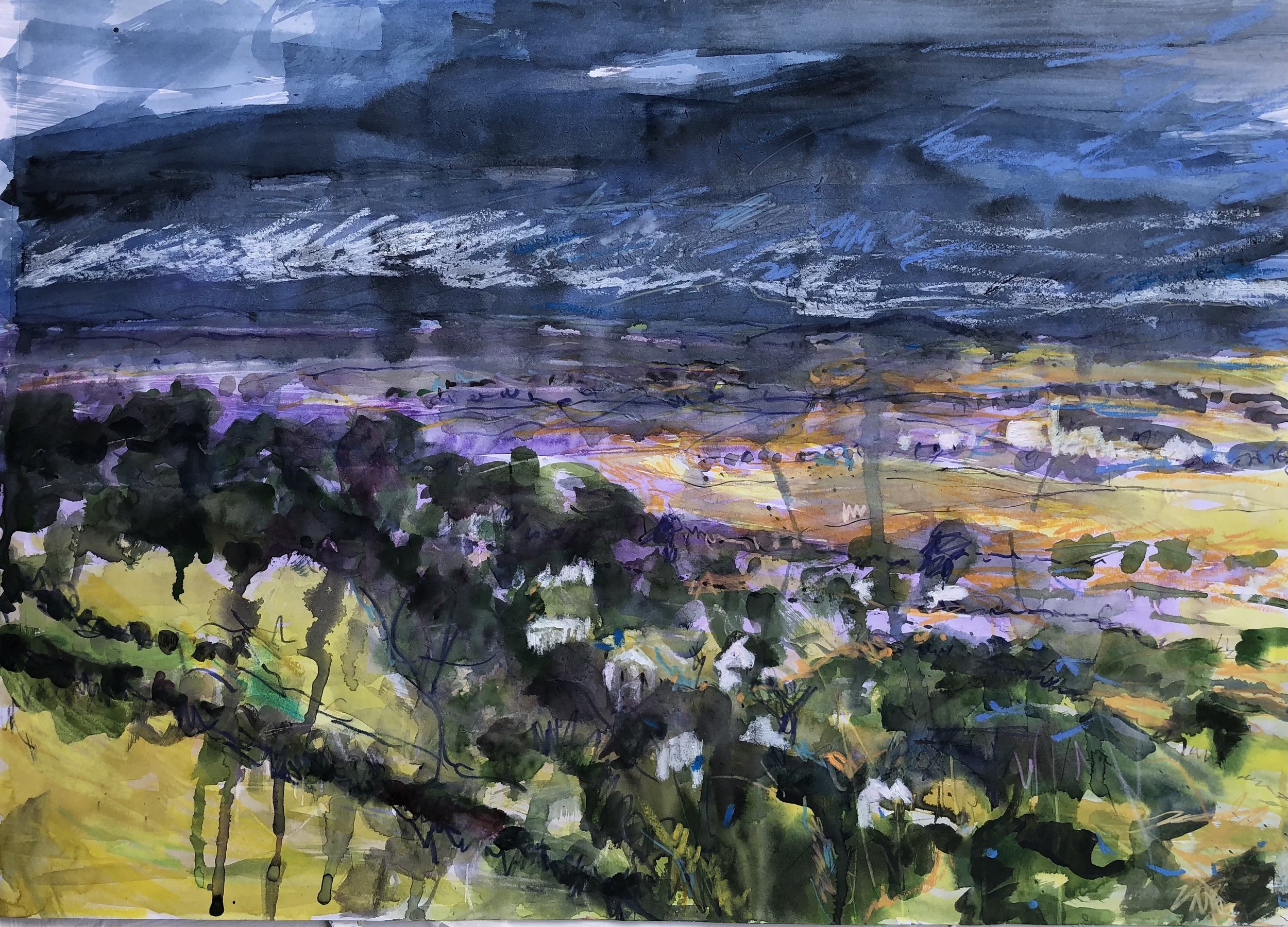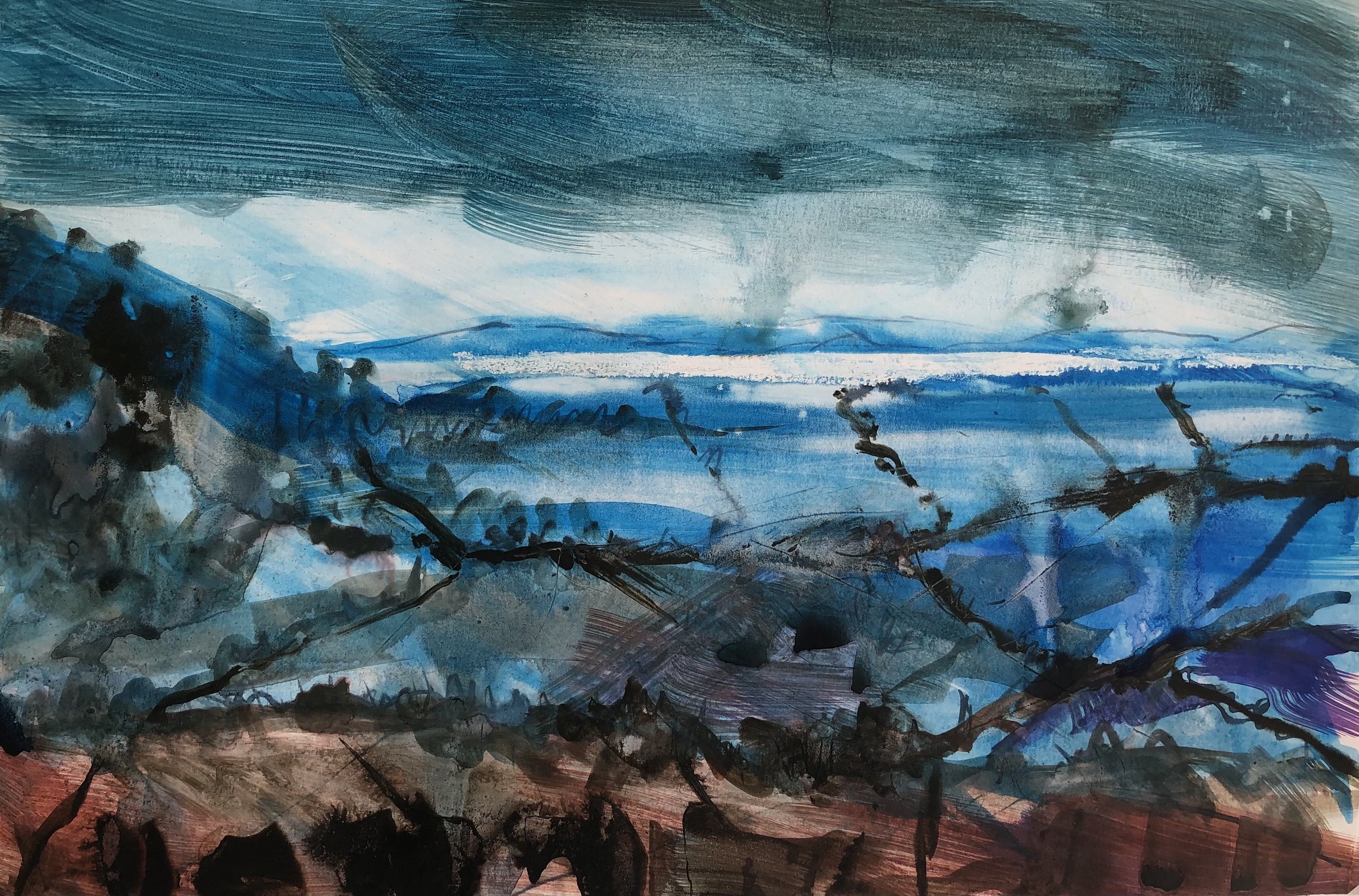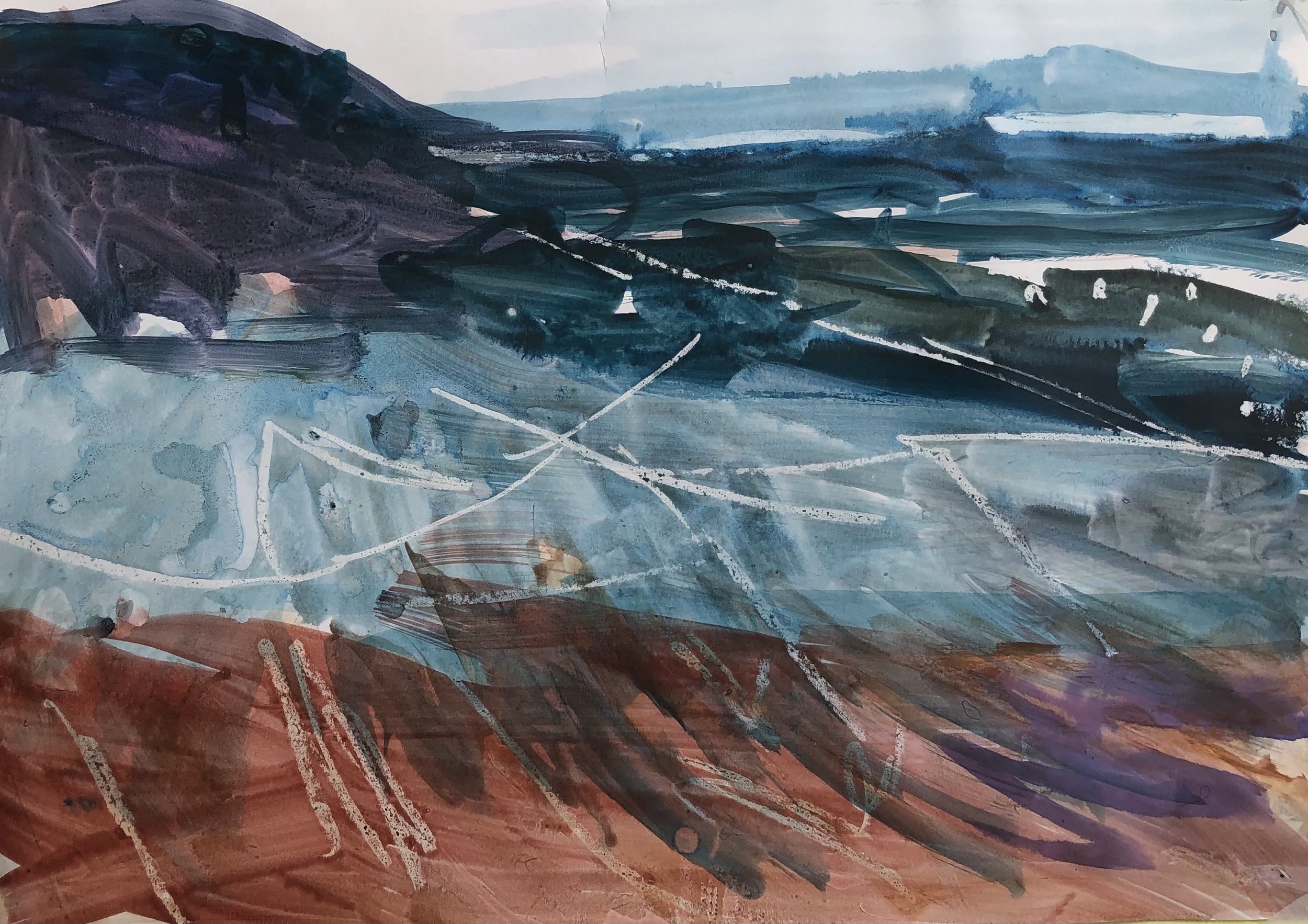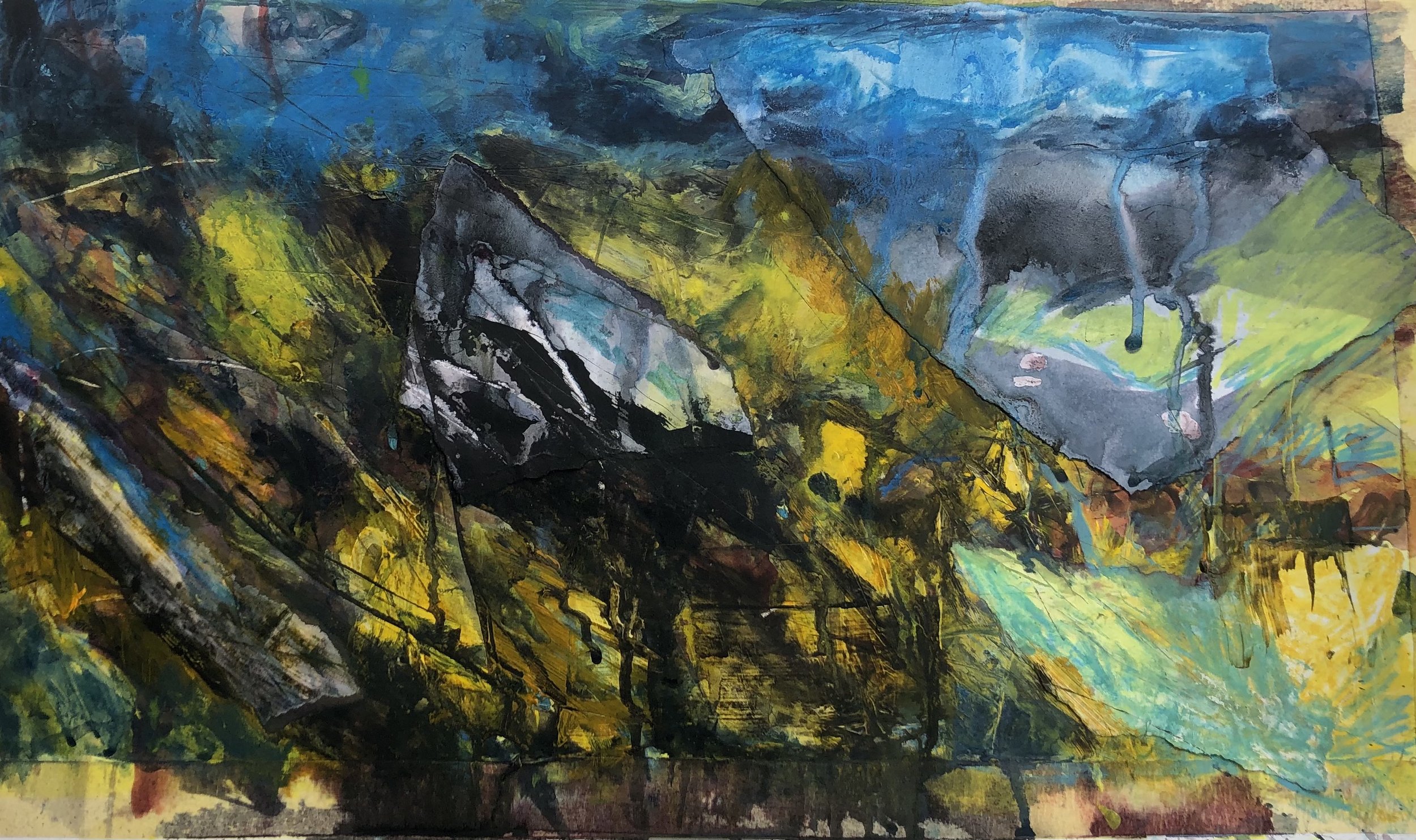Unfolding
Artist and writer Deborah Cox on learning to see landscapes, internal and external, for what they really are
Content warning: contains references to domestic violence.
I’ve always written creatively, but as an artist, I’ve been engaged in the visual language of printmaking and painting. I went to Art school in London in the 1990s and have more recently finished an MA in Fine Art. Now, however, I would like to engage with my writing in more depth, drawing upon my experiences of growing up in Gloucestershire. Writing rather than painting feels the most appropriate medium for what I have to say. However it will mean learning and honing a different set of creative skills.
Having grown up in Gloucestershire I have a deep, emotional, connection to this landscape and draw upon it in my painting. I’m interested in exploring how this experience can inform my writing, and what parallels might be found.
Recently I’ve been exploring in my painting the parts of the landscape we don’t see; beneath the surface, in plain site or in the case of Google Earth from above.
Next to The Calcot Hotel and Spa in Tetbury is a poultry farm. It’s set back from the road and consists of several stark, green buildings with air vents and grain storage. There are no signs anywhere to say to say what it is, only prominent CCTV. No sounds, smells or feathers to indicate that thousands of sentient beings live inside these buildings and are being ‘processed’ in the most horrendous conditions.
Calcot Farm, Tetbury
Interestingly, if you look on Google Earth, unlike The Calcot Hotel and Spa, there is no name to these buildings, just a series of coordinates.
Calcot poultry farm on Google Earth
So I ask myself the question when driving through the landscape , who is making the decision to select out places and why?
Deborah Cox - Calcot Poultry Farm. Draft painting. Acrylic mixed media 45cm x 60cm
Exploring what we don’t see is also autobiographical.
As a child I lived in a quaint, 300 year old cottage in Chalford Hill, which literally had roses around the door. Anyone walking by would think what an amazing place to grow up.
However, the Cotswold stone walls were very thick and no one knew what went on behind closed doors.
We might think of violence in the home as happening in inner city areas with a certain demographic.
When we look at a pretty Cotswold cottage, we project onto this, our own preconceived fantasies of rural village life. We carry inside us the notion of the happy, nuclear family which we’ve seen on cereal boxes and TV.
Similarly, when we look at the countryside, we project onto it our often unconsciously received notions of the rural idyll.
Are we so caught up in the 19th century Romantics’ purity and glorification of Nature that we can’t possibly notice an intensive chicken farm as we drive by in this Area of Outstanding Natural Beauty? Or have we also been coerced into this not seeing?
In this triptych of paintings I use the Western narrative of sequencing from left to right, to follow the development of an idyllic scene in Nature, a path in Sladebank Woods in Stroud.
Deborah Cox - Path Through Woods During Anthropocene. Mixed media on canvas, 240 cm x 65 cm, Draft tryptich using Photoshop
The Romantics often used Nature to symbolise their inner feelings, but also to externalise their highest ideals.
In the first painting, I’ve used the path through the wood as a metaphor for the individual’s journey in life.
In the second painting, painted during the Australian bush fires, I explore the effect of climate change.
The third painting represents the progression of that destruction into a metaphysical realm.
I ask myself how much of our idealisation of the Natural world has meant an alienation and a refusal to see and believe the real world, which in turn is leading to its demise?
Anthropologist Tim Ingold coined the concept of ‘the dwelling perspective’, in which he imagines the landscape as a continually unfolding story. The landscape he believed, bears witness to the passing of time, it contains the memory of all who have lived in it.
When we perceive the landscape we are also immersed in this unfolding and when we tell our own stories we become part of this living process.
I became interested in the view towards The River Severn from Selsley Hill and made several paintings culminating in a triptych.
The view shows The River Severn which played a pivotal role in slavery, with its connection to the Bristol Channel.
Stroud wool and various merchandise was transported on The River Severn and goods were also brought back from The Colonies.
Deborah Cox - View from Selsley Common Unfurling. draft (photoshop) 360x90cm
Places like Lypiatt Park in Bisley and Durham Park near Bath, were built from the profits and compensation from slavery.
When painting a landscape I’m particularly aware of using techniques with the paint and mixed media to create layers and a sense of depth and history.
I imagined the kind of artefacts, such as an axe, a rabbit trap and leg shackles that might still be left in the soil from centuries of human presence. They represented for me the voices and cries of humans and animals still present in the landscape.
During the Covid lockdown I felt unable to work in my studio. Every time I went in, I felt nauseous. This went on for months and I became increasingly distressed. The worst thing was not understanding why I couldn’t engage with my work.
With reflection, I came to realise that the preceding few years had been relentlessly difficult, dealing with life events, such as buying a house and moving, managing building projects and having a hospital operation. On top of this the nightly news of people dying in hospital with Covid. My body had locked into an almost permanent state of flight and fight, just waiting for the next crisis. No wonder I hadn’t felt relaxed enough to paint.
One morning as I was unravelling some of these threads in my mind………. I saw her.
A little girl.
She was only about six, curled up at the bottom of the stairs, peering through the crack in the door that led into the living room.
She followed with her eyes and breath every blurred shape that went back and forth across the room. Her heart was beating fast.
“Don’t tell me you didn’t know!” her father, a dark shape, strode towards her mother.
“You’re lying to me again!.” He was shouting now and raising his fist. Her mother was backing away.
Let’s call this little girl Vigilance.
Every night Vigilance sits on these stairs following the movements and actions of her parents. She’s listening intently to the intonation in their voices.
How bad will it be tonight?
She doesn’t go to bed.
She sits silently witnessing.
If she’s not there to save her mother’s life no one else will.
She’s already planned the route out of the garden to the telephone box.
“999 ambulance please!”
She doesn’t go to bed until her parents have gone to bed.
She doesn’t sleep until they are quiet and the whole house is silent.
No one knows the heavy responsibility she bears.
Vigilance! Oh Vigilance I’m so sorry you endured this for so many years. I thought you’d gone from my life. but there you are still keeping watch, unable to be a child; to play, to be safe.
She had reappeared in my life,
in my studio,
watching,
waiting
for the next emergency.
It had been impossible for me to relax,
to play,
to paint with her there.
The truth is Vigilance has never left me.
She probably never will.
She continues to remind me of what lies beneath the surface, what isn’t seen and why.
“Don’t tell anyone what happened last night,” my mother would say to me as I left for school still trembling.
The experience of her revisiting me has made me want to tell her story.
Her experiences are so easily buried by the roses around the door and by an unconscious collective need to present a palatable picture.
It’s about bringing those experiences out into the light from inside, or from beneath or behind.
Experiences that were never witnessed and have been so buried in the landscape that no one is quite sure whether they existed.
It’s about opening up those buildings of unending cruelty that are right beneath our noses and saying:
“Really?”
“Did that happen?”
“Is it still happening?”
Deborah Cox - View From Selsley Common. acrylic mixed media on canvas 120x90cm
I’m at the beginning of my writing journey.
Not necessarily to tell my story, but to contribute to the unfolding of experiences unseen.
I’m exploring different formats and structures.
A short story? Written in the third person? Prose? Flash fiction? Humour?
However, unlike the idealised landscape of the triptych, my path through the woods will also include the broken bottles, the discarded fridges and the disappearing fauna and flora.
Not the idealised landscape, but the one we actually live in.
Deborah Cox was born and brought up in Gloucestershire. She went to Art School in London in the 1990s and has recently finished an MA in Fine Art. She worked for many years as a printmaker and exhibited at The Royal West of England Academy and Bath Society of Artists as well as Spike Island and The Ginger Gallery in Bristol. She has since concentrated on painting and draws much of her enthusiasm and ideas from living and working in the Gloucestershire landscape.
Below images are Deborah Cox - View from Selsley Common I - V Mixed media on paper, 35x30cm











